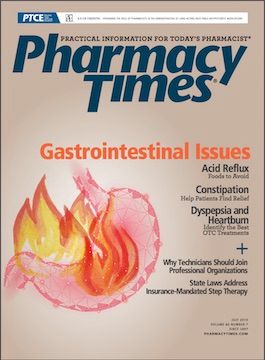Publication
Article
Pharmacy Times
Identify How and When to Treat Dyspepsia and Heartburn
Author(s):
Pharmacists are instrumental in guiding patients on the appropriate and safe use of products for gastrointestinal discomfort.
The upper gastrointestinal (GI) tract consists of the duodenum, the esophagus, and the stomach.1,2 Although many factors may contribute to upper GI pain, some may be minor and can be self-treated, whereas others may require further and immediate medical treatment. Possible causes of upper GI pain include appendicitis, bowel obstruction, diverticulitis, dyspepsia, flatulence, gallstones, gastritis, gastroenteritis, heartburn, liver or pancreas issues, and muscle pain.2,3 In many cases, one condition may cause another complication, and patients need to know when to seek further medical care and evaluation.2,3 For example, gallstones may cause liver dysfunction, whereas ulcers may cause indigestion.2,3 Depending on the types of symptoms and degrees of severity, upper GI pain can be either a minor inconvenience or a sensation so intense that it makes functioning difficult. This article focuses on mild-to-moderate cases of dyspepsia and heartburn that patients can self-treat with OTC products and nonpharmacologic measures.
At some point, everyone experiences the discomfort associated with dyspepsia and heartburn, but unfortunately, some individuals suffer GI discomfort on a regular basis. Dyspepsia and heartburn are common complaints that, if left unresolved, can negatively affect an individual’s overall quality of life, including day-to-day functioning, the ingestion of certain foods, and sleep.4,5
Heartburn, or pyrosis, is characterized as a burning sensation arising from the substernal area and moving toward the neck or the throat.4 The 2 main types are nocturnal heartburn, which occurs during sleep and is often responsible for interrupting sleep, and postprandial heartburn, which occurs within 2 hours after eating a meal, when bending over, or when lying down.4,5 Heartburn is a common symptom of gastroesophageal reflux disease (GERD).4
Dyspepsia is pain that manifests in the gastroduodenal region. Symptoms may include burning, early satiation, epigastric pain, postprandial fullness, and upper abdominal bloating.2-4 Heartburn commonly occurs with dyspepsia, which may be classified as organic (having an identifiable cause) or functional (having no identifiable organic systemic or metabolic disease as a cause).4,6
An estimated 60 million individuals in the United States experience heartburn at least once a month, and more than 15 million experience it daily, according to the American College of Gastroenterology.6
Because pharmacists are likely to encounter patients seeking guidance on the plethora of OTC products formulated to prevent and treat mild-to-moderate cases of dyspepsia and heartburn, they should be prepared to counsel patients. Before recommending any OTC products for dyspepsia and heartburn, pharmacists should ascertain whether self-treatment is appropriate. Pharmacists are also instrumental in identifying patients at increased risk of developing dyspepsia and heartburn because of certain lifestyle habits, medical conditions, or pharmacologic agents, as well as in directing those with symptoms that necessitate further medical care to seek evaluation.
During counseling, advise patients that episodes of heartburn that are frequent, last longer than 3 months, or are persistent are the most common symptoms of GERD, which if left untreated can cause long-term complications, such as Barrett esophagus, esophageal cancer, esophagitis, and GI bleeding.7 Chronic heartburn may also increase an individual’s risk of throat cancer, according to the American Cancer Society. Therefore, it is important that individuals with frequent heartburn receive appropriate treatment as soon as possible.8
Patients with dyspepsia and heartburn may present with a bitter or sour taste in the mouth; choking or coughing, especially while lying down; excessive burping; frequent interruptions of sleep caused by indigestion; a hoarse, sore throat; a painful burning sensation in the chest, just behind the sternum, characteristically within 1 to 4 hours after eating; and regurgitation of food.4
When selecting an OTC product to self-treat dyspepsia and heartburn, patients should consider factors such as contraindications; cost; dosage forms and intervals; the duration, frequency, and severity of their symptoms; and potential drug interactions. Pediatric patients, individuals with preexisting medical conditions, and women who are lactating or pregnant should consult their primary care practitioner before using any of these products. To avoid further complications, patients with persistent and recurring episodes of heartburn and those exhibiting atypical or severe symptoms should be referred to their primary care practitioner for further medical evaluation. In addition, if symptoms show no signs of improvement or worsen after 14 days of self-treatment, patients using these OTC products should seek immediate medical care.
Pharmacists can also recommend nonpharmacologic strategies for diminishing the severity of or preventing the incidence of dyspepsia or heartburn, such as avoidance of large meals, greasy or spicy foods, and late-night eating; smoking cessation; and weight loss.
The American Gastroenterology Association offers an excellent patient resource at patients.gi.org/topics/acid-reflux/.
Yvette C. Terrie, BSPharm, RPh, is a consulting pharmacist and a medical writer in Haymarket, Virginia.
REFERENCES
- Kapoor VK. Upper GI tract anatomy. Medscape website. emedicine.medscape.com/ article/1899389-overview. Updated June 28, 2016. Accessed May 6, 2019.
- Villines Z. What causes upper stomach pain? Medical News Today website. medicalnewstoday.com/articles/324591.php. Updated February 28, 2019. Accessed June 4, 2019.
- Davis CP. Abdominal pain causes. MedicineNet website. medicinenet.com/ abdominal_pain_causes/views.htm. Updated August 7, 2018. Accessed May 4, 2019.
- GI patient center. American Gastroenterological Association website. gastro.org/ patient-care/conditions-diseases/gerd. Accessed May 4, 2019.
- Whetsel T, Zweber A. Heartburn and dyspepsia. In: Krinsky D, Berardi R, Ferreri S, et al, eds. Handbook of Nonprescription Drugs. 19th ed. Washington, DC: American Pharmacists Association; 2018.
- Moayyedi PM, Lacy BE, Andrews CN, Enns RA, Howden CW, Vakil N. Corrigendum: ACG and CAG clinical guideline: management of dyspepsia. Am J Gastroenterol. 2017;112(9):1484. doi: 10.1038/ajg.2017.238.
- MacGill M. What is acid reflux? Medical News Today website. medicalnewstoday.com/ articles/146619.php. Updated November 13, 2017. Accessed May 4, 2019.
- Can esophageal cancer be prevented? American Cancer Society website. cancer.org/ cancer/esophagus-cancer/causes-risks-prevention/prevention.html. Updated June 14, 2017. Accessed May 4, 2019.







